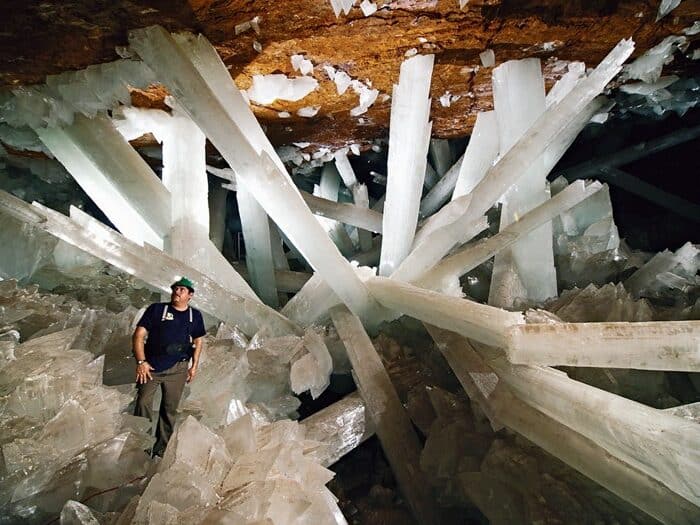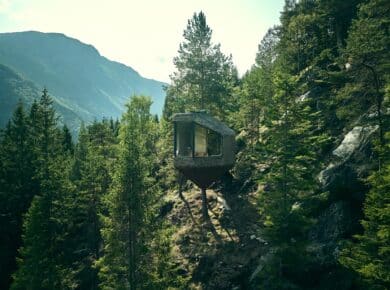
Introduction to the Cave of Crystals
The Cave of Crystals, also referred to as the Giant Crystal Cave, stands as a remarkable natural phenomenon located within a mountain near Naica, Mexico. This awe-inspiring cave was serendipitously discovered in the year 2000 by miners engaged in the extraction of lead, zinc, and silver from the Naica mine. The discovery of this subterranean marvel unveiled a spectacle of extraordinary selenite crystals, which have since garnered significant attention due to their unparalleled size and beauty. Some of these crystals extend over 11 meters in length and weigh up to 55 tons, making them among the largest crystals ever found on Earth.
Situated approximately 300 meters below the surface, the Cave of Crystals has captivated the scientific community since its unveiling. The discovery sparked intense curiosity and excitement among geologists, mineralogists, and other researchers, who were eager to study the unique conditions that led to the formation of such gigantic crystals. Initial analyses revealed that the cave’s high temperatures, coupled with mineral-rich hydrothermal fluids, created the perfect environment for the growth of these colossal selenite formations over the course of hundreds of thousands of years.

The Cave of Crystals is not only a geological wonder but also a testament to the intricate and often hidden processes of Earth’s internal dynamics. The scientific community’s reaction to this discovery was one of astonishment and profound interest, prompting numerous studies and explorations aimed at understanding the cave’s unique environment and the factors contributing to its crystal growth. The initial findings have provided valuable insights into crystallography and the geological history of the region, positioning the Cave of Crystals as a key subject of ongoing research and fascination.
Formation and Geology of the Crystals
The formation of the colossal selenite crystals within the Cave of Crystals in Naica, Mexico, is a remarkable geological phenomenon that spans millions of years. The process began with the unique confluence of several critical factors, including the presence of mineral-rich hydrothermal fluids, a stable high-temperature environment, and a saturation of gypsum in the water. These conditions were essential for the extraordinary growth of the crystals, some of which reach lengths of up to 12 meters.
Approximately 26 million years ago, tectonic activity led to the formation of the Naica mine, initiating a series of geological events that would eventually create the Cave of Crystals. The key to the crystal formation lies in the cave’s consistent temperature, which remained around 58 degrees Celsius (136 degrees Fahrenheit). This stable, high-temperature environment allowed for the slow and steady growth of selenite crystals.

Hydrothermal fluids, rich in calcium sulfate, percolated through the limestone bedrock, creating a supersaturated solution. Over time, these fluids filled the cave’s chambers. The high temperature and the presence of water maintained the solution in a liquid state, which is crucial for crystal growth. As the temperature and pressure conditions remained stable, the calcium sulfate slowly crystallized, forming the massive selenite structures.
Scientists believe that the growth process of these crystals was uninterrupted for hundreds of thousands of years. The slow rate of crystallization is attributed to the cave’s stable conditions, which prevented the formation of smaller, less stable crystals. Instead, the selenite crystals grew to their enormous sizes, creating the awe-inspiring spectacle observed today.
The Cave of Crystals stands as a testament to the intricate and prolonged geological processes that govern our planet. By understanding the specific conditions and natural forces at play, we gain a deeper appreciation for the extraordinary natural wonders that lie beneath the Earth’s surface.
Challenges of Exploring the Cave
Exploring the Cave of Crystals in Naica, Mexico, presents formidable challenges that demand utmost caution and preparation. The cave’s environment is extraordinarily hostile, with temperatures soaring up to 58 degrees Celsius (136 degrees Fahrenheit) and humidity levels approaching 100%. These extreme conditions create a hazardous atmosphere where heat exhaustion and dehydration are significant risks for anyone venturing inside. As such, specialized equipment and protective gear are indispensable for explorers and scientists.
One of the primary pieces of equipment necessary for safe exploration is a cooling suit. These suits are designed to regulate body temperature and prevent heat stress, allowing researchers to spend limited time within the cave. Additionally, explorers must carry ample water supplies and use hydration packs to counteract the rapid loss of fluids due to the intense heat and humidity.
Breathing within the cave is another critical issue. The high humidity makes the air thick and difficult to inhale, necessitating the use of respirators or breathing apparatuses to ensure adequate oxygen intake. Moreover, the cave’s delicate environment means that any exploratory activities must be conducted with minimal disruption to preserve its pristine condition.
Several significant expeditions have taken place in the Cave of Crystals, each contributing valuable insights and discoveries. One notable expedition led by a team of scientists from the National Geographic Society revealed the presence of microorganisms trapped inside the crystals, which have been dormant for thousands of years. These findings offer a glimpse into the ancient microbial life and its potential implications for understanding life in extreme environments.
In addition to scientific discoveries, these expeditions have highlighted the sheer scale and beauty of the cave’s crystal formations. The largest crystals can reach lengths of up to 12 meters (39 feet) and weigh as much as 55 tons, making them among the most spectacular natural wonders on Earth. Despite the challenges, the allure of uncovering the secrets of the Cave of Crystals continues to drive researchers and explorers to brave its harsh conditions.
The Future of the Cave of Crystals
The future of the Cave of Crystals in Naica, Mexico remains a topic of concern due to its delicate and fragile environment. This natural wonder, renowned for its colossal selenite crystals, faces numerous threats. Conservation efforts are paramount to ensure its preservation for future generations.

One of the primary threats to the Cave of Crystals is the ongoing mining activities in the Naica mine. The cave was discovered during mining operations, and while these activities have since ceased, the potential for future mining poses a significant risk. Any disturbance to the underground water levels could lead to the destabilization of the cave’s structure, potentially damaging the crystals.
Climate change also presents a looming threat. Changes in temperature and humidity levels can affect the cave’s delicate equilibrium. The crystals formed under specific conditions over millions of years, and any variation could lead to their degradation. It is imperative to monitor and manage the cave’s microclimate to prevent irreversible damage.
Human interference, including unauthorized access and vandalism, further endangers the Cave of Crystals. The fragile environment can be easily disturbed by physical contact, and the introduction of foreign substances can alter the cave’s natural state. Strict regulations and monitoring are necessary to protect this unique ecosystem from human-induced harm.
Scientific research plays a crucial role in understanding and protecting the Cave of Crystals. Studies on the cave’s geology, mineralogy, and climate conditions are essential for developing effective conservation strategies. Collaborative efforts between scientists, researchers, and conservationists can lead to innovative solutions for preserving this natural wonder.
Local and international organizations have undertaken several initiatives to ensure the cave’s preservation. These include the establishment of protective measures, awareness campaigns, and funding for ongoing research. By fostering global cooperation and raising awareness, we can work together to safeguard the Cave of Crystals for future generations.



